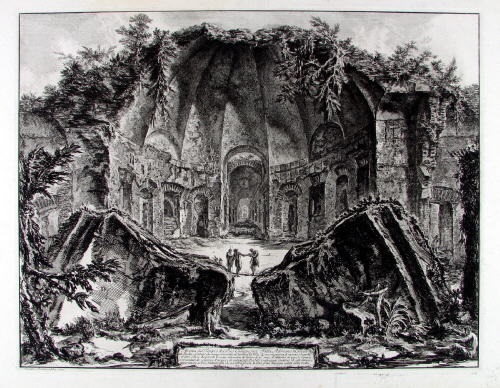Scan barcode
A review by fionnualalirsdottir
Mémoires d'Hadrien by Marguerite Yourcenar
In the notes at the back of this book, Marguerite Yourcenar tells us that in 1941 she stumbled upon some Piranesi engravings in a shop in New York. One of them was a view of the interior of Hadrian’s Villa as it might have looked in the 1740s. I say ‘might have’ because the famous Piranesi had a talent for adding interesting layers to his engravings of the monuments of Rome. What his contemporaries viewed as simply ruins, took on new life in his rendering, imbued with the phantasms of his peculiar imagination.

Yourcenar, who had been researching Hadrian’s life for many years, interprets Piranesi’s version of Hadrian’s Villa as the inside of a human skull upon which strands of vegetation hang like human hair. She recognizes Piranesi’s genius in conveying an hallucinatory echo of the tragic interior world of the Villa’s former owner, the Emperor Hadrian, and she praises Piranesi’s medium-like gifts, his ability to be an extraordinary intermediary between the Villa and the Emperor.
When I had digested her words, it occurred to me that this is exactly how I’d describe her own achievement in this book. Hers too are medium-like gifts; she is an extraordinary intermediary between Hadrian and the reader. We are inside his head, quite an hallucinatory experience.
And there’s a further parallel between the Piranesi engraving and Yourcenar’s book. Piranesi chose to represent the part of the villa known as the Temple of Canope which Hadrian had created as a space to commemorate Antinous, the dead Greek youth he idolized. The statue of Antinous which Hadrian had placed in the centre of that space was no longer there in Piranesi’s time but it is interesting that among the many possible views of Hadrian’s Villa which Piranesi could have selected, he chose the exact site of the missing statue. Antinous dominates Piranesi’s work by his absence - just as he dominated Hadrian’s life by his absence, and Yourcenar’s book in turn.
It seemed fitting to seek out the missing statue though it’s not been an easy task. We know it was a Bacchus but among the many statues of Antinous that exist, several depict him as Bacchus. The large marble known as the Braschi Antinous, now in the Vatican Museums, corresponds best perhaps to Yourcenar’s description of the statue that she believes once stood in Hadrian’s Temple of Canope.

Yourcenar mentions the fine Italian marble from which the statue has been delicately chiselled, and the motif of vine leaves circling the slightly bent and sorrowful head which she interprets as a reference to the early harvest of the young man’s life: L’œuvre d'Antonianus a été taillée dans un marbre italien...Elle est d'une délicatesse infinie. Les rinceaux d'une vigne encadrent de la plus souple des arabesques le jeune visage mélancolique et penché : on songe irrésistiblement aux vendanges de la vie brève, à l'atmosphère fruitée d'un soir d'automne..
Yourcenar’s book is itself as beautiful as that block of marble and as delicate as the vine motif.
No one has ever created fictional biography quite like this.

Yourcenar, who had been researching Hadrian’s life for many years, interprets Piranesi’s version of Hadrian’s Villa as the inside of a human skull upon which strands of vegetation hang like human hair. She recognizes Piranesi’s genius in conveying an hallucinatory echo of the tragic interior world of the Villa’s former owner, the Emperor Hadrian, and she praises Piranesi’s medium-like gifts, his ability to be an extraordinary intermediary between the Villa and the Emperor.
When I had digested her words, it occurred to me that this is exactly how I’d describe her own achievement in this book. Hers too are medium-like gifts; she is an extraordinary intermediary between Hadrian and the reader. We are inside his head, quite an hallucinatory experience.
And there’s a further parallel between the Piranesi engraving and Yourcenar’s book. Piranesi chose to represent the part of the villa known as the Temple of Canope which Hadrian had created as a space to commemorate Antinous, the dead Greek youth he idolized. The statue of Antinous which Hadrian had placed in the centre of that space was no longer there in Piranesi’s time but it is interesting that among the many possible views of Hadrian’s Villa which Piranesi could have selected, he chose the exact site of the missing statue. Antinous dominates Piranesi’s work by his absence - just as he dominated Hadrian’s life by his absence, and Yourcenar’s book in turn.
It seemed fitting to seek out the missing statue though it’s not been an easy task. We know it was a Bacchus but among the many statues of Antinous that exist, several depict him as Bacchus. The large marble known as the Braschi Antinous, now in the Vatican Museums, corresponds best perhaps to Yourcenar’s description of the statue that she believes once stood in Hadrian’s Temple of Canope.
Spoiler

Yourcenar mentions the fine Italian marble from which the statue has been delicately chiselled, and the motif of vine leaves circling the slightly bent and sorrowful head which she interprets as a reference to the early harvest of the young man’s life: L’œuvre d'Antonianus a été taillée dans un marbre italien...Elle est d'une délicatesse infinie. Les rinceaux d'une vigne encadrent de la plus souple des arabesques le jeune visage mélancolique et penché : on songe irrésistiblement aux vendanges de la vie brève, à l'atmosphère fruitée d'un soir d'automne..
Yourcenar’s book is itself as beautiful as that block of marble and as delicate as the vine motif.
No one has ever created fictional biography quite like this.